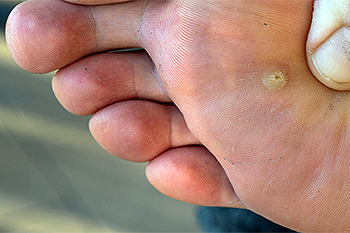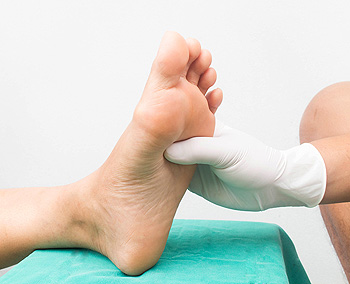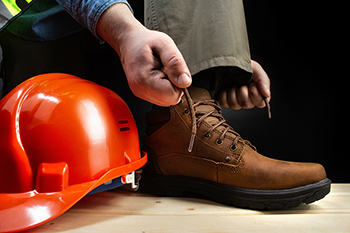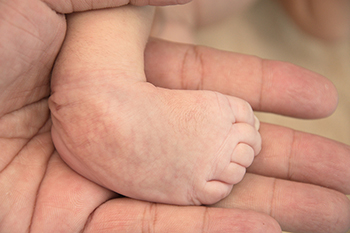November 2023
Decoding the Telltale Symptoms of Plantar Warts

Plantar warts, though often benign, leave their mark on the soles of your feet with distinctive symptoms that merit attention. Typically emerging as flat or slightly raised growths, these warts exhibit a rough texture and may feature small black dots known as wart seeds, caused by clotted blood vessels. While the appearance is unmistakable, it is the discomfort that often draws attention. Plantar warts can cause pain or tenderness, especially while standing or walking, as the pressure on the wart exacerbates the discomfort. The surrounding skin may take on a calloused appearance, and the warts themselves can vary in size. Plantar warts thrive in warm, moist environments, making them frequent visitors to communal spaces like swimming pools or locker rooms. Recognizing these symptoms enables early identification and intervention, ensuring a more comfortable and expedited resolution of this common foot ailment. Plantar warts require the medical attention of a podiatrist, and if you have this ailment, it is suggested that you contact this type of doctor who can offer effective remedies for the accompanying pain and discomfort.
Plantar warts can be very uncomfortable. If you need your feet checked, contact Genine Befumo, DPM from University Foot and Ankle Center, L.L.C. Our doctor will assist you with all of your foot and ankle needs.
About Plantar Warts
Plantar warts are the result of HPV, or human papillomavirus, getting into open wounds on the feet. They are mostly found on the heels or balls of the feet.
While plantar warts are generally harmless, those experiencing excessive pain or those suffering from diabetes or a compromised immune system require immediate medical care. Plantar warts are easily diagnosed, usually through scraping off a bit of rough skin or by getting a biopsy.
Symptoms
- Lesions on the bottom of your feet, usually rough and grainy
- Hard or thick callused spots
- Wart seeds, which are small clotted blood vessels that look like little black spots
- Pain, discomfort, or tenderness of your feet when walking or standing
Treatment
- Freezing
- Electric tool removal
- Laser Treatment
- Topical Creams (prescription only)
- Over-the-counter medications
To help prevent developing plantar warts, avoid walking barefoot over abrasive surfaces that can cause cuts or wounds for HPV to get into. Avoiding direct contact with other warts, as well as not picking or rubbing existing warts, can help prevent the further spread of plantar warts. However, if you think you have developed plantar warts, speak to your podiatrist. He or she can diagnose the warts on your feet and recommend the appropriate treatment options.
If you have any questions please feel free to contact our office located in Monroe Township, NJ . We offer the newest diagnostic and treatment technologies for all your foot and ankle needs.
Causes of Peripheral and Diabetic Neuropathy

Peripheral neuropathy affects parts of the nervous system that send signals to the extremities. Symptoms typically emerge in the toes and feet before symmetrically progressing up the legs. In diabetic neuropathy, another prevalent type, symptoms initiate in both feet, extend to the calves, and may reach the hands. Symptoms include a tingling sensation, burning pain, loss of feeling, and the inability to sense temperature or vibration. While diabetic neuropathy can cause tingling, numbness, and reduced sensation, weakness is less prominent. Notably, a significant number of individuals with diabetic neuropathy may not experience pain, despite reduced sensation. This puts them at risk of neglecting proper foot care and potentially leading to serious injuries, or in severe cases, limb loss. Diabetes is a major contributor to peripheral neuropathy, and nerve compression, excessive alcohol consumption, toxin exposure, and certain medications such chemotherapy can also cause this condition. Autoimmune diseases, hereditary conditions, thyroid disease, and kidney or liver diseases are other potential triggers. If you believe you are suffering from peripheral or diabetic neuropathy in the feet, it is suggested that you make an appointment with a podiatrist for an exam and treatment options.
Neuropathy
Neuropathy can be a potentially serious condition, especially if it is left undiagnosed. If you have any concerns that you may be experiencing nerve loss in your feet, consult with Genine Befumo, DPM from University Foot and Ankle Center, L.L.C. Our doctor will assess your condition and provide you with quality foot and ankle treatment for neuropathy.
What Is Neuropathy?
Neuropathy is a condition that leads to damage to the nerves in the body. Peripheral neuropathy, or neuropathy that affects your peripheral nervous system, usually occurs in the feet. Neuropathy can be triggered by a number of different causes. Such causes include diabetes, infections, cancers, disorders, and toxic substances.
Symptoms of Neuropathy Include:
- Numbness
- Sensation loss
- Prickling and tingling sensations
- Throbbing, freezing, burning pains
- Muscle weakness
Those with diabetes are at serious risk due to being unable to feel an ulcer on their feet. Diabetics usually also suffer from poor blood circulation. This can lead to the wound not healing, infections occurring, and the limb may have to be amputated.
Treatment
To treat neuropathy in the foot, podiatrists will first diagnose the cause of the neuropathy. Figuring out the underlying cause of the neuropathy will allow the podiatrist to prescribe the best treatment, whether it be caused by diabetes, toxic substance exposure, infection, etc. If the nerve has not died, then it’s possible that sensation may be able to return to the foot.
Pain medication may be issued for pain. Electrical nerve stimulation can be used to stimulate nerves. If the neuropathy is caused from pressure on the nerves, then surgery may be necessary.
If you have any questions, please feel free to contact our office located in Monroe Township, NJ . We offer the newest diagnostic and treatment technologies for all your foot care needs.
Types of Workplace Foot Injuries

Studies have shown the majority of workplace related injuries that affect the feet are punctures, crushing, sprains, lacerations, slips, trips, and falls. Stepping on nails, shards of glass, or other sharp objects can result in puncture wounds to the feet. These injuries can be particularly dangerous, as they can introduce bacteria into the body, possibly leading to infections. Sharp tools and equipment can cause lacerations to the feet, resulting in bleeding and the risk of infection. Slips and falls can be attributed to wet floors, cluttered walkways, or uneven surfaces. When an employee falls, the feet are often the first point of contact with the ground, making them susceptible to injuries such as fractures, sprains, and bruises. Standing for extended periods of time on hard flooring, combined with wearing ill fitting shoes, can lead to foot fatigue. Fatigue can set employees up for further injuries and decrease their alertness. The main way to avoid many of these types of injuries is by wearing protective footwear appropriate for the type of work environment. If you need help managing foot conditions that result from work related injuries, it is suggested that you consult a podiatrist.
While working on the feet, it is important to take the proper care of them. For more information about working on your feet, contact Genine Befumo, DPM from University Foot and Ankle Center, L.L.C. Our doctor will treat your foot and ankle needs.
Working on Your Feet
Standing on your feet for long periods of time can cause stress and pain in your feet. Your whole body may experience change in terms of posture, back pain, bunions, callouses and or plantar warts. There are ways to avoid these conditions with proper foot care, smart choices and correct posture.
Positive Changes
Negative heeled shoe – Choosing this shoe type places the heel slightly lower than the ball of the foot. These are great for overall foot health. Find shoes that fit you correctly.
Go barefoot – Our feet were not designed to be enclosed for all hours of the day. Try to periodically expose your feet to air.
Eliminate Pain
Foot Exercises – Performing simple exercises, incorporating yoga and doing stretches are beneficial. This will allow increased blood flow to the area and muscles of the foot.
Achilles tendon – Stretching the foot out flat on the floor will relax the calf muscles and tendon. These exercises can be performed almost anywhere. Make sure you add these exercises to your daily regimen.
With a little bit of this information and knowing more about foot health, you will notice changes. Foot stretches and proper footwear will help with pain and prevent further issues.
If you have any questions please feel free to contact our office located in Monroe Township, NJ . We offer the newest diagnostic and treatment technologies for all your foot and ankle needs.
Heel Pain Can Be Treated!
Treatment of Clubfoot

Idiopathic congenital clubfoot, often referred to simply as clubfoot, is the most common congenital deformity. This condition can affect one or both of an infant’s feet and is noticeable as the feet are turned inward and downward. The sole of the foot can also face in, and the foot may appear shorter due to an increased arch. The word idiopathic signifies the exact cause of the condition is unknown. This differentiates it from cases that are linked to specific underlying conditions or syndromes. The Ponseti method is often used by podiatrists to treat clubfoot. This method involves manipulation and casting, which allows most children with the condition to achieve a functional and aesthetically pleasing result with their feet. If your child is born with clubfoot, it is suggested that you make an appointment as quickly as possible with a podiatrist, as effective treatment generally begins within the first few weeks of birth.
Congenital foot problems require immediate attention to avoid future complications. If you have any concerns, contact Genine Befumo, DPM of University Foot and Ankle Center, L.L.C. Our doctor can provide the care you need to keep you pain-free and on your feet.
Congenital foot problems are deformities affecting the feet, toes, and/or ankles that children are born with. Some of these conditions have a genetic cause while others just happen. Some specific foot ailments that children may be born with include clubfeet, polydactyly/macrodactyly, and cleft foot. There are several other foot anomalies that can occur congenitally. What all of these conditions have in common is that a child may experience difficulty walking or performing everyday activities, as well as trouble finding footwear that fits their foot deformity. Some of these conditions are more serious than others. Consulting with a podiatrist as early as possible will help in properly diagnosing a child’s foot condition while getting the necessary treatment underway.
What are Causes of Congenital Foot Problem?
A congenital foot problem is one that happens to a child at birth. These conditions can be caused by a genetic predisposition, developmental or positional abnormalities during gestation, or with no known cause.
What are Symptoms of Congenital Foot Problems?
Symptoms vary by the congenital condition. Symptoms may consist of the following:
- Clubfoot, where tendons are shortened, bones are shaped differently, and the Achilles tendon is tight, causing the foot to point in and down. It is also possible for the soles of the feet to face each other.
- Polydactyly, which usually consists of a nubbin or small lump of tissue without a bone, a toe that is partially formed but has no joints, or an extra toe.
- Vertical talus, where the talus bone forms in the wrong position causing other bones in the foot to line up improperly, the front of the foot to point up, and the bottom of the foot to stiffen, with no arch, and to curve out.
- Tarsal coalition, when there is an abnormal connection of two or more bones in the foot leading to severe, rigid flatfoot.
- Cleft foot, where there are missing toes, a V-shaped cleft, and other anatomical differences.
- Macrodactyly, when the toes are abnormally large due to overgrowth of the underlying bone or soft tissue.
Treatment and Prevention
While there is nothing one can do to prevent congenital foot problems, raising awareness and receiving neonatal screenings are important. Early detection by taking your child to a podiatrist leads to the best outcome possible.
If you have any questions please feel free to contact our office located in Monroe Township, NJ . We offer the newest diagnostic tools and technology to treat your foot and ankle needs.
Blog Archives
- April 2024
- March 2024
- February 2024
- January 2024
- December 2023
- November 2023
- October 2023
- September 2023
- August 2023
- July 2023
- June 2023
- May 2023
- April 2023
- March 2023
- February 2023
- January 2023
- December 2022
- November 2022
- October 2022
- September 2022
- August 2022
- July 2022
- June 2022
- May 2022
- April 2022
- March 2022
- February 2022
- January 2022
- December 2021
- November 2021
- October 2021
- September 2021
- August 2021
- July 2021
- June 2021
- May 2021
- April 2021
- March 2021
- February 2021
- January 2021
- December 2020
- November 2020
- October 2020
- September 2020
- August 2020
- July 2020
- June 2020
- May 2020
- April 2020
- March 2020
- February 2020
- January 2020
- December 2019
- November 2019
- October 2019
- September 2019
- August 2019
- July 2019
- June 2019
- May 2019
- April 2019
- March 2019
- February 2019
- January 2019
- December 2018
- November 2018
- October 2018
- September 2018
- August 2018
- July 2018
- June 2018
- May 2018
- April 2018
- March 2018
- February 2018
- January 2018
- December 2017
- November 2017
- October 2017
- September 2017
- August 2017
- July 2017
- June 2017
- May 2017
- April 2017
- March 2017
- February 2017
- January 2017
- December 2016
- November 2016
- October 2016
- September 2016
- August 2016
- July 2016
- June 2016
- May 2016
- April 2016
- March 2016
- February 2016
- January 2016
- December 2015
- November 2015
- October 2015
- September 2015
- August 2015
- July 2015
- June 2015
- May 2015
- April 2015
- March 2015
- February 2015
- January 2015
- December 2014
- November 2014
- October 2014
- September 2014
- August 2014
- July 2014





